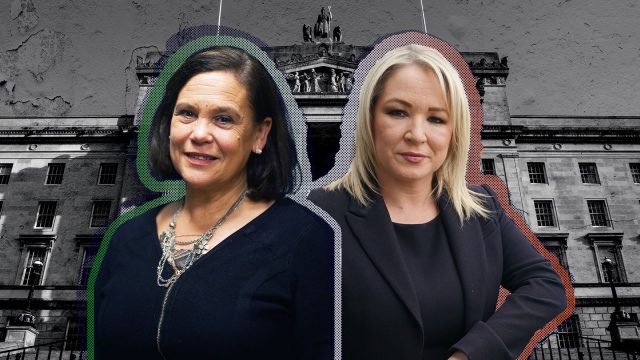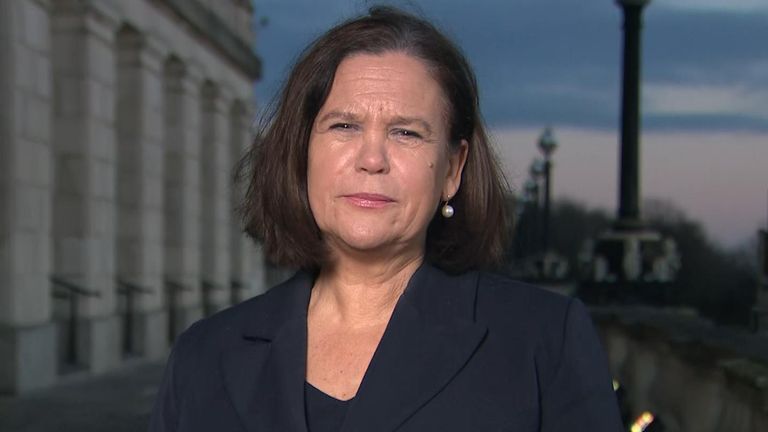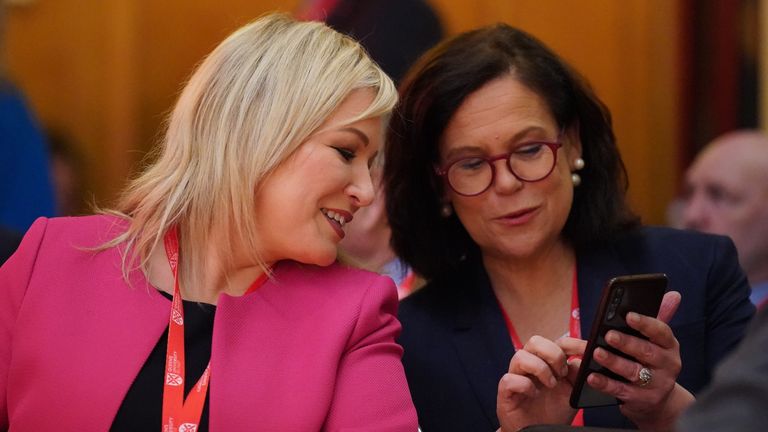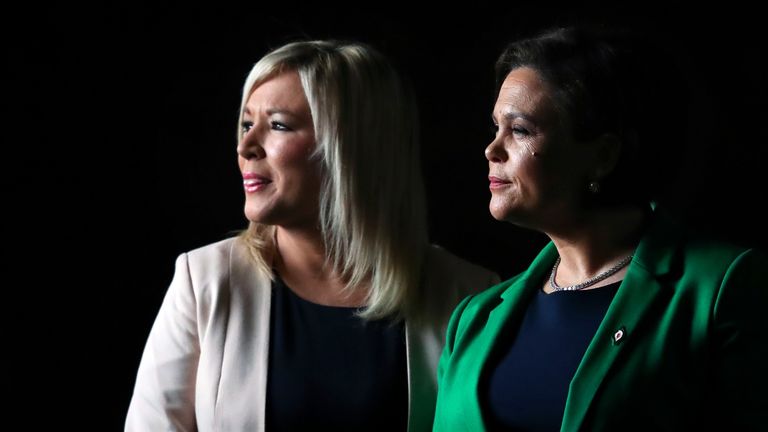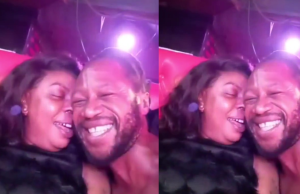The confirmation of Michelle O’Neill as first minister of Northern Ireland is historic.
She is the first representative of the nationalist community, committed to uniting Ireland, to become the leader of the Stormont Assembly, an integral part of the devolved United Kingdom.
Ms O’Neill is also complemented in the south by another woman, Mary Lou McDonald, the president of their party, Sinn Fein, and the leader of the opposition in the Irish parliament.
As polls stand Ms McDonald is on course to be the first woman prime minister of Ireland.
The two leaders often appear together and were pictured on newspaper front pages after the Democratic Unionist Party (DUP) lifted its block on re-establishing the power-sharing government in Northern Ireland.
Asked about a united Ireland Ms McDonald sounded confident. “In historic terms, it is within touching distance,” she told reporters.
Is she right though? Not according to the Westminster government. The 76-page document enshrining the deal with the DUP which MPs endorsed is called Safeguarding the Union and is shot through with language affirming Northern Ireland’s constitutional status as part of the UK.
Ms O’Neill and Ms McDonald clearly have electoral appeal.
Both women grew up in the Catholic community in republican families. Ms O’Neill’s father, Brendan Doris, was interned as a provisional IRA prisoner and served as a Sinn Fein councillor.
Middle-class Ms McDonald’s credentials are more remote: her great uncle, James O’Connor, an IRA member, was executed by the British during the Irish Civil War. That is ancient history, Ms O’Neill and Ms McDonald would have us believe.
Dispelling the shadow of the gunman
The rise in the popularity of Sinn Fein is attributed in part to attracting women, especially from Catholic backgrounds, to vote for them, precisely because they dispel the shadow of the gunman. The two mothers of two seem to many to be the embodiment of the republican movement’s switch to seek power via the ballot box rather than the bullet.
Unlike the previous generation of Sinn Fein leadership, typified by Martin McGuinness and Gerry Adams, neither were active during the so-called “armed struggle” of the Troubles. Ms O’Neill became a member of Sinn Fein at the age of 21 after the Belfast Agreement was signed on Good Friday 1998.
Around the same time, Ms McDonald, who is eight years older, briefly joined Fianna Fail, one of Ireland’s two mainstream parties. By 2002, she was running unsuccessfully for office as a Sinn Fein candidate. She served a term for Sinn Fein in the European Parliament from 2004 and has been a TD, a member of Dail Eireann, Ireland’s parliament, since 2011.
McDonald favourite to be next taoiseach
Ireland is due to hold a general election in the next 12 months. Sinn Fein tops the opinion polls with 27%, ahead of the current coalition partners Fine Gael on 20% and Fianna Fail on 17%.
That makes Ms McDonald favourite to be the next taoiseach. If so, Ireland would be united at least in having female Irish republican political leaders in both the north and south.
Read more:
O’Neill ‘contests’ claim Irish unity is ‘decades’ away
O’Neill becomes first nationalist first minister
Why NI’s new first minister is hugely symbolic
Of course, Ms McDonald may not be elected and Ms O’Neill may not actually be first minister for long.
Stormont could well be suspended again. Ms O’Neill has already twice lost the post of deputy first minister when her DUP counterparts as first minister, Arlene Foster and Paul Givan, each resigned.
Communities have refused to share power
The Northern Ireland Assembly has not sat for nearly half its existence since 1998 because one of the two communities, unionist or nationalist, refused to share power in the executive with the other.
Under the Belfast Agreement, the first and deputy first ministers have equal authority. The symbolically important top job goes to the party which has the most members of the legislative assembly elected.
Sinn Fein had 27 MLAs at the last election. Ms O’Neill qualifies to be first minister because the unionist vote is split between parties, with the DUP on 25 MLAs and Ulster Unionists with nine.
The Troubles stuttered to an end in the 1990s because neither side could win the terrorist conflict, which claimed over 3,000 lives in some 30 years.
Prime ministers have tried to appease Northern Irish public
Rapprochement between the Irish and British governments was facilitated by the two countries being members of the European Union, and by the consequent modernisation of Ireland.
The UK’s referendum vote in 2016 to leave the EU was especially problematic for Northern Ireland. A clear majority in the six counties voted to remain to no avail, while the then dominant DUP were fierce Brexiteers.
Since then, successive British prime ministers have tried to appease the Northern Irish public – and intermittently to honour the UK’s commitments under the Belfast agreement – by keeping Northern Ireland, uniquely, in both the EU and UK trading blocks.
Growing support for united Ireland
Support for a united Ireland grew, with 57% of the rising generation of 18-24-year-olds in Northern Ireland favouring it in opinion polls. By no means all Catholics want a united Ireland but in demographic terms they are overtaking Protestants.
The DUP considered threats to the union lay in measures which kept trade borders open, “north-south”, with the EU, but imposed them, “east-west”, with mainland Britain. That, and a largely unspoken objection to the idea of a Roman Catholic republican woman as the political leader of Northern Ireland, lay behind their refusal, now lifted, to take part in the devolved government.
For the time being re-establishing Stormont could be a smart move by the Unionists.
Responsibilities of office have dampened separatist urge
A united Ireland remains the automatic Article One in any Sinn Fein manifesto. But interview Ms McDonald on the campaign trail and she is much more interested in housing and inequality.
Ms O’Neill has been calling for the return of Stormont so she can govern and sort out Northern Ireland’s problems. The Westminster government has made funding for public services conditional on a functioning assembly.
From Scotland to Catalonia, the responsibilities of office have dampened the separatist urge. Public enthusiasm for big constitutional changes fades when voters just want whoever is in power to deliver.
The Good Friday Agreement says a united Ireland will come about if there is a public desire on both sides of the border for a referendum and if both the people of Northern Ireland and Ireland both vote, separately, for it.
The Irish prime minister, Leo Varadkar, 45, says we are “on a path” to a united Ireland “in my lifetime”. Sir Keir Starmer, the British leader of the opposition, argues “it’s not even on the horizon”.
Ms McDonald is a politician to her fingertips and speaks as one. “Touching distance” sounds very close until you put it in the “historic context” of half a millennium’s disputation.
Michelle O’Neill is appearing on Sunday Morning With Trevor Phillips on Sky News from 8.30am this morning

